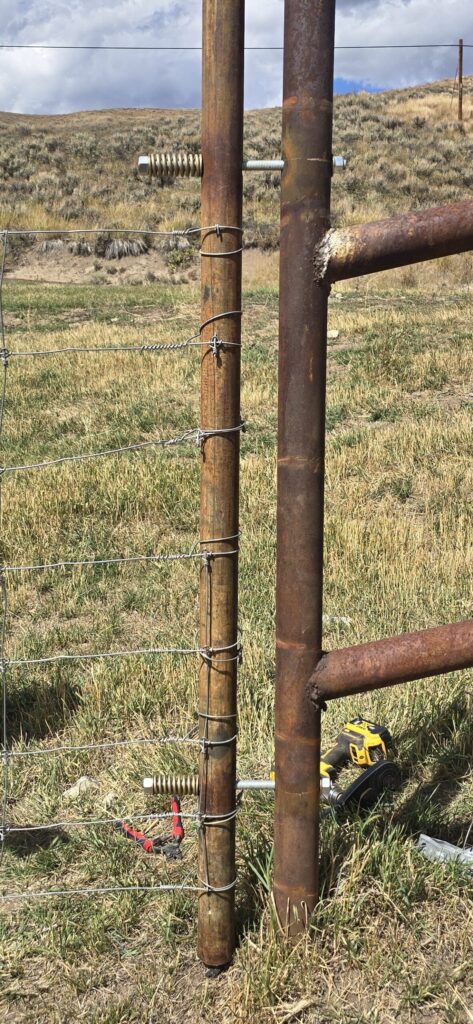Fences are a major obstacle to wildlife migrations in the Yellowstone Ecosystem. Since its inception in 2018, the Ricketts Conservation Foundation (RCF) has partnered with Jackson Fork Ranch (JFR) to make wildlife friendly fence modifications to the bison fence that stretches along the upper Hoback River. Beginning in 2019, RCF worked with JFR and the Wyoming Game and Fish Department (WGFD) to install 22 wildlife crossings in the fence. This improved wildlife movements across the ranch greatly. In 2024, JFR decided to enhance the wildlife crossings even further. They proposed to design let-down fence sections up to 1200’ in length in targeted areas where known mule deer migration corridors cross the ranch.

Photo 1. Holes are drilled and hinges are placed at the ends of each section of fence to allow the fence to pivot.
After consulting with WGFD, RCF assisted with this effort in spring of 2025 by inventorying the identified migration corridors at Horse Pasture Draw and Nutting Draw. JFR then hired a local welding company to modify the fence posts. The welder added sleeves at the bottom of some posts, which allow for the post to be lifted off its base easily. Other posts have rebar stays that the fence was then tied to, with cups to hold the rebar in place on both the bottom and top of the fence post. In addition, by modifying the ends of each section, the fence can pivot (Photo 1), lay flat, and thus present less of an obstacle to migrating animals.
Once completed, these sections of fence were to be let down on October 15 (Photo 2), just in time for the fall mule deer migration. However, the Jackson Fork Ranch is surrounded primarily by the U.S. Forest Service Hoback Grazing Allotment, which permits seasonal grazing by cattle and horses. Wyoming is a fence-out state, so it was imperative to coordinate with neighboring users regarding the timing of letting the fence down. RCF coordinated with the Hoback Grazing Association so JFR could reach its goal to improve wildlife movement across the ranch without complicating roundup.

Photo 2. A section of fence that has been let down for wildlife passage.
RCF and JFR will continue to work with WGFD to monitor the use of these segments by migrating wildlife and determine if any additional modifications need to be made to the fence in the future.
As a private landowner, it’s important to continue learning about your property and how to align your vision with what takes place in the surrounding landscape. It’s never too late to improve your management when you find out something you didn’t know that you didn’t know. In this case JFR was unaware of the mule deer migration corridor when they erected the bison fence. However, once they were made aware of this, they worked with RCF to remedy the situation.
RCF continues to partner with WGFD, focusing on additional opportunities to improve mule deer migration movement within the Hoback River watershed in 2026. We will continue to support landowners that now know what they didn’t know before and choose to reduce their impact on the landscape through wildlife friendly fence improvements.
Stay tuned for more information in 2026.